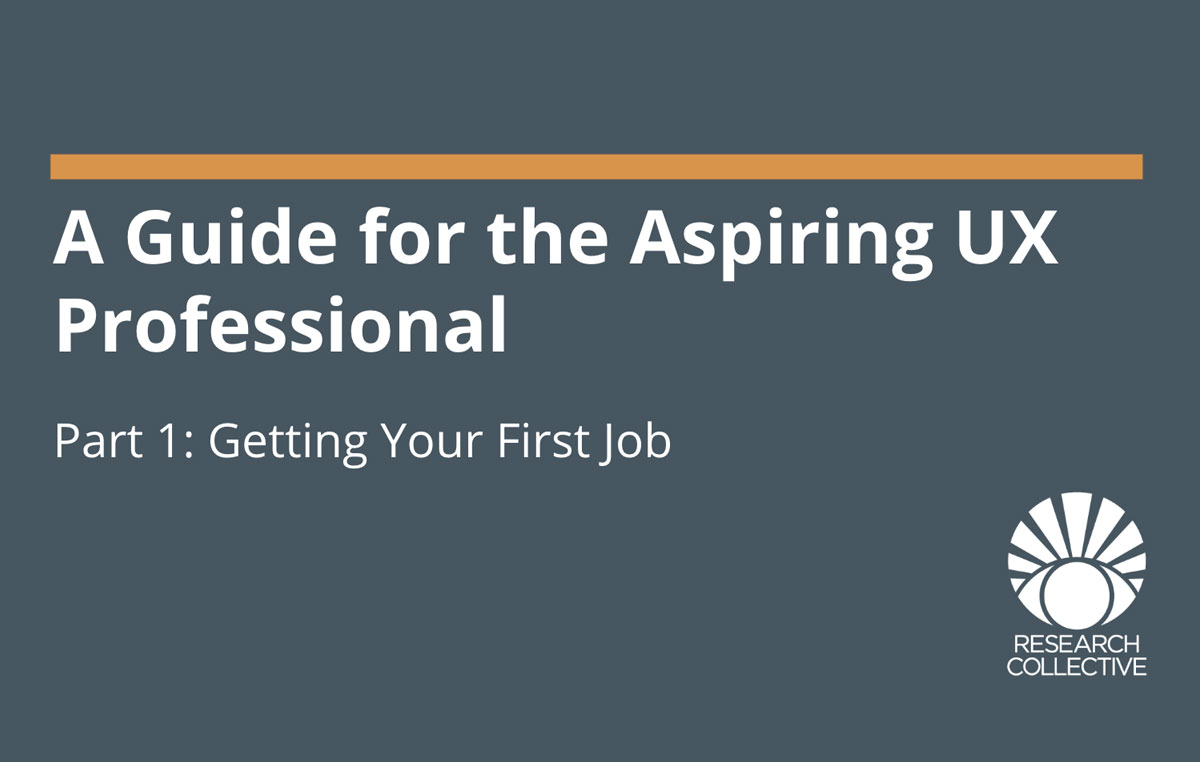Introduction
New professionals entering into UX encounter a common problem. Employers want entry level candidates to have 1-3 years of experience, but how does one accumulate experience without a job? Any “entry-level UX professional” has surely felt the pain of this dilemma, firsthand.
As someone who recently navigated these waters, I learned a few things along the way. Some of the tips in this article are fairly straightforward; you may have heard about them in one manner or another. Others may be new to you. Aspiring UXer, here is your guide to kicking off a career in the rapidly growing field of user experience.
Network with anyone who will listen.
Successful networking involves four basic components: frequency, persistence, speed, and quality.
Frequency
“Frequency” is a tried-and-true factor in networking, business, and sales. The more swings you take toward the ball, the more likely that you will hit it at least once. The state lottery slogan of, “you can’t win if you don’t play” sums this point up perfectly. Aim to network with as many people, as often as possible. Be open to speaking with anyone who will listen. And, of course, listen to what they have to say in return.

Persistence
“Persistence” refers to trying again when your first or fifth email or phone call fails to generate a reply. It also describes an unwavering commitment to reaching out to new people (i.e., tying back to “frequency”), even when many of the new people you meet will not be able to offer a direct line to achieving your professional goals. You kiss a lot of frogs, but if you stick to it (and wipe the slime from your lips) you’ll eventually find the right one.
Speed
“Speed” relates to your ability to network several times in a day. It’s difficult to maintain the “frequency” element of networking if you’re not limiting the duration of each connection to a reasonable, short period of time. Your networking encounters should be brief and respectful of the other person’s time (as well as your time too).
Work on a 10-second, 30-second, and 60-second professional “elevator pitch” which should be succinct and action-oriented. You should be able to quickly describe your professional goals to the person with whom you are networking. Additionally, that person should know exactly what you want him or her to do after the conversation ends.
Having a short and long version of your elevator pitch helps when conversations may be drawn out or abbreviated. Events like conferences often yield unpredictable circumstances and conversation; it’s good to be ready for anything. Don’t get caught flat-footed if the person you are speaking with wants to know more about you.
Quality
“Quality” refers to your ability to offer something valuable in the networking exchange. This can be a unique perspective on a problem, a publication s/he should read, a person s/he should get in touch with, or a program or tool s/he that might be helpful for a given problem. Just like in any other conversation, networking is a two-way street. Be able to offer that person something other than just a statement about what you want in life.
Quality also refers to your willingness to maintain relationships over time. Far too often, people connect on LinkedIn, only to never speak with each other ever again. This is a missed opportunity for networking. While that connection does “boost” your numbers on LinkedIn, it misses on actually connecting at a professional level. Is that not the main point of social media platforms like LinkedIn. Maintaining relationships over time takes substantial effort and energy, but can pay off in many ways over the long haul.
Use social media and in-person meetings in a complementary way.
Use capabilities of the web to set up meetings with prospective employers. This is an area where few people thrive and most of us feel incredibly awkward. However, networking is one of the most important areas to push yourself to the limit in order to meet people who matter. Marketing yourself in person cannot be beaten.
Branch Out
Go to meetups. Get busy on LinkedIn. Ask your old professors for recommendations. Ask your connections for more connections. All of these can get you in-person meetings. This is a time to be aggressive because no one has anything to lose by networking. My personal favorite is a classic: ask your connection to send an introductory email for you (this makes your name mean something), follow with your own introductory email (gives the person a chance to think/adjust), and invite them to coffee or lunch (facetime, for the win).
You Never Know…
Every single person you meet could change your life, and you could do the same for them. Just because a connection may not offer you a job, that doesn’t mean they aren’t worth knowing. 1) They might offer you an opportunity later on, and; 2) they may introduce you to someone who will sooner. Your new connection might know someone who can help you, and that possibility makes connecting with them 100% worth it.
When you are pursuing these endeavors, be kind. Be professional. Be courteous. Do not waste other people’s time and always frame your discussions not by how the person can help you, but how you can help them.
In the business world, this is referred to as an “education-based sales” technique. You offer something to someone else that advances his or her knowledge, without the expectation that s/he will offer anything in return. Often, however, people feel inclined to return the favor regardless. This could be in the form of a friendly wave or smile at a professional conference, or perhaps the name of a professional looking to hire someone just like you.
Read broadly and boldly.
In your extra time, read as often as possible. This can be in the form of UX-related books, journal publications, or even blogs in your field of interest. Blogs can be especially helpful in UX because there are so many good options out there to choose from. Plus, almost all of them are free, easy to read, and they are up-to-date with discussions about the latest technologies. Importantly, blogs can also help you get a sense of what’s going on in the UX industry, where the current trends are taking us, and who the trusted experts are. Some big UX blogs are UXBooth, UsabilityGeek, and The UX Blog, MeasuringU.
Don’t Forget the Basics
Make it a point to stay sharp on key terms and concepts in research. Details such as the differences between an independent and dependent variable, between vs. within-subject study designs, and the various types of validity (ex., construct validity, internal validity) are important to remember and talk about while planning studies.
Read broadly whenever possible. That is, read publications and books around your professional interests, not just directly within them. If you’re a tech person read tech articles, but don’t dismiss design articles altogether. There is often a fair amount of overlap that can help you think about problems or information in different ways.
In addition to books and blogs, don’t ignore the scientific literature. The major journals are widely read and highly respected by academia and industry alike. Research methods are often communicated via these channels, and being familiar with the details of these methods will be a great way to stay current and impress in the interview room.
Subscribe
If you’re a student, subscriptions to many of the main human factors or UX journals are either free or cheap. The Human Factors and Ergonomics Society (HFES) and User Experience Professionals Association (UXPA) both have journals (and conferences!) that will be read far and wide. An annual fee is a small price to pay for these resources.
“T” up your skills.
Being marketable to a company is heavily dependent on what you bring to the table. What skills do you have? What can you help the company do in an efficient and effective manner? Which strategies or approaches will you use to resolve a specific problem?
Building up a strong skillset is a wise move in the highly competitive job market. However, you also need to balance the breadth of skills and how deep you should dive into each one. A good approach to follow with skill development is to think of it as a “T”.
Breadth
At the top of your “T”, you have a broad range of skills but developed only to a shallow level. You have the introductory knowledge to talk about the skill or complete basic tasks, but not enough to innovate. Although this seems counterproductive, the top of your T accomplishes two things.
First, it allows you to speak the same language as shareholders, other members of the UX industry, or those in tangential industries to UX. This is important when it comes to being an effective contributor in cross-functional teams and gaining trust. Second, it allows you to identify topics you’d like to know more about. You may discover that developing a deep understanding of tangential information is a good fit with your professional interests and goals.
Depth
At the stem of your “T” is your skill depth. While starting in UX, find one skill that will get you the biggest bang for your buck in terms of helping you professionally. This might be something like learning to use biometric equipment, operating a 3D printer, or an analysis program such as R, SPSS, or MATLAB. (Side note: Excel is essential to learn in UX.)
If you aren’t sure where to start looking for skills you should develop, consider signing up for a lynda.com account. This is a great website to get your feet wet in a lot of different topics at a low cost. You can explore different skill options to see what might be a good fit with your professional needs and interests. PRO TIP: check to see if your local library offers access to a free lynda.com account, some of them do!
Like most of these tips, developing a new skill can be the differentiator between you and your competition. The more you know and the more you can do entering a new job, the less time and money the employer has to put into training you, which will always make you an attractive resource.
If you don’t have work experience, create your own.
One of the trickiest parts about getting your first job in the UX field is the fact that most employers want a significant amount of working experience before considering a candidate. Not surprisingly, this is very difficult to manage for undergraduate and graduate students alike. Often, they are overwhelmed with class projects, capstones, internships, theses, and dissertation research, making it a challenge to gain the firsthand experience necessary to enter the industry.
Keep in mind too, that while internships are a step in the right direction – and you should definitely have at least one before graduating – a semester-long internship is not the same thing as several years of experience.
Just Do It
So, what do you do in this situation? If you don’t have a job to give you projects, make your own projects. Find something, anything, to develop your skills as a designer, researcher, developer, whatever. Show employers that you can do all this stuff because you truly already have, from start to finish. This could include conducting a series of heuristic evaluations on a website or product, or even a small-scale usability study with a recently released printer or mobile app. Yes, it is more work, and yes, there is no pay, but it’s a clear way to demonstrate your personal and professional interest in UX to prospective employers.
Be sure to find a balance point between the workload on these projects and the expected payoff. As you start with your first few projects, aim to complete each one quickly. The goal is to learn the steps involved. Later projects will help you focus on refining your skills and knowledge within each step at a deeper level.
Ask For Help
Starting your own project is not something that’s easy to do, but it’s a chance for you to let your creativity run free and really do good work. There are no deadlines or limitations, so take the time to do great work and take out all the stops that you know of. Feel free to collaborate with someone. Don’t be afraid to ask for help from a respected mentor/advisor. Running a project is not only a time to grow and learn, but also to make mistakes. All of these things will be invaluable to you in the future.
Good luck!
The above tactics won’t guarantee anything for sure, but I promise you they will help! Networking, developing career skills, and continual learning demonstrates to prospective employers that you are highly qualified and willing to put in the extra miles to improve their company.
Part 2 of this guide contains advice on having a successful first six months at a new job!

